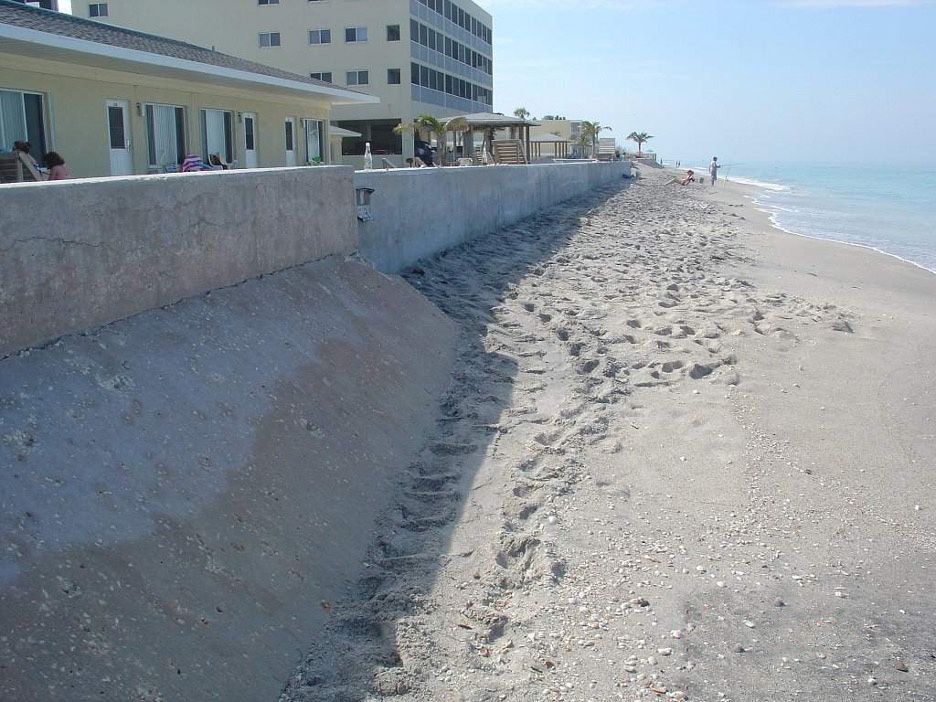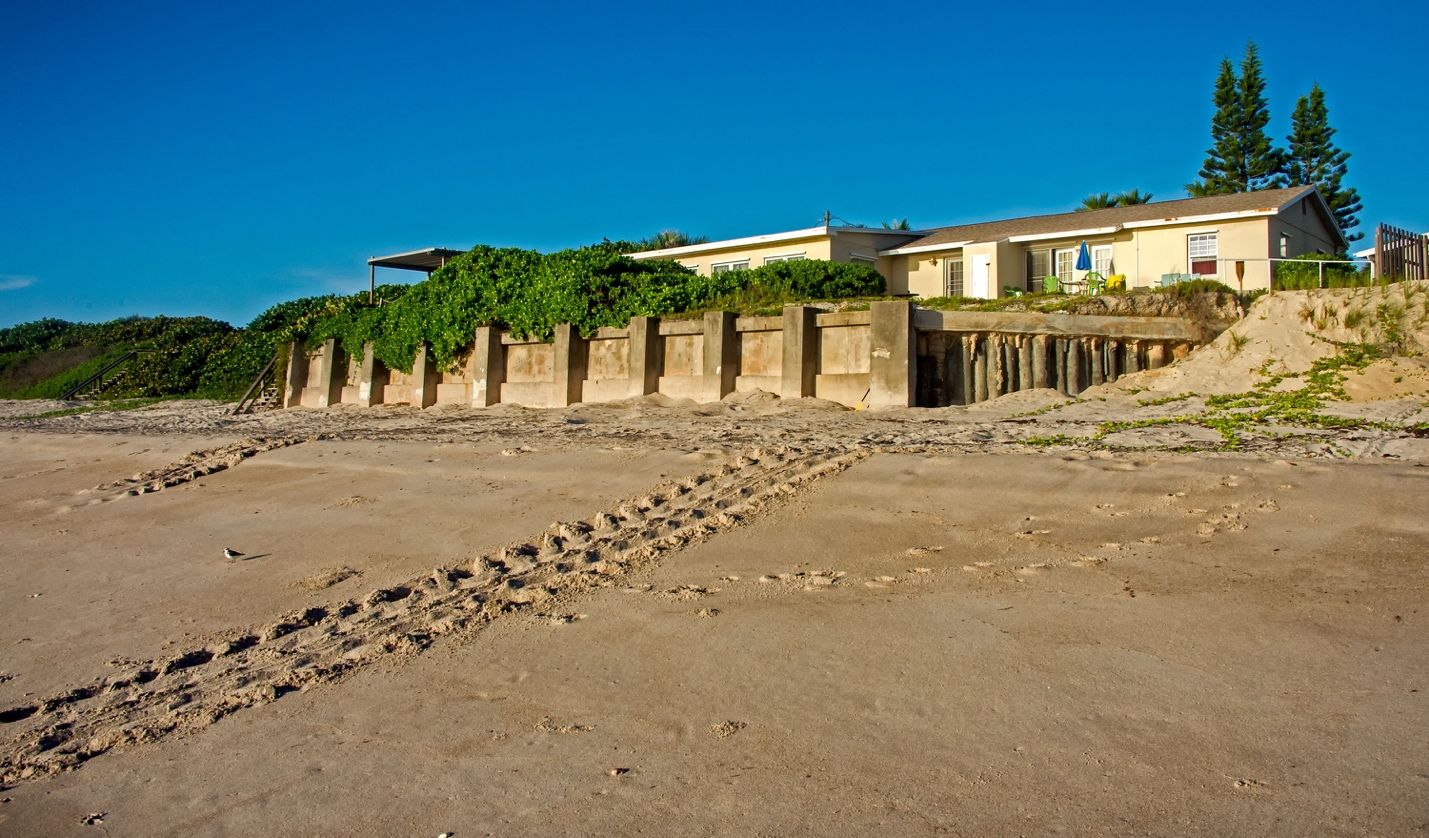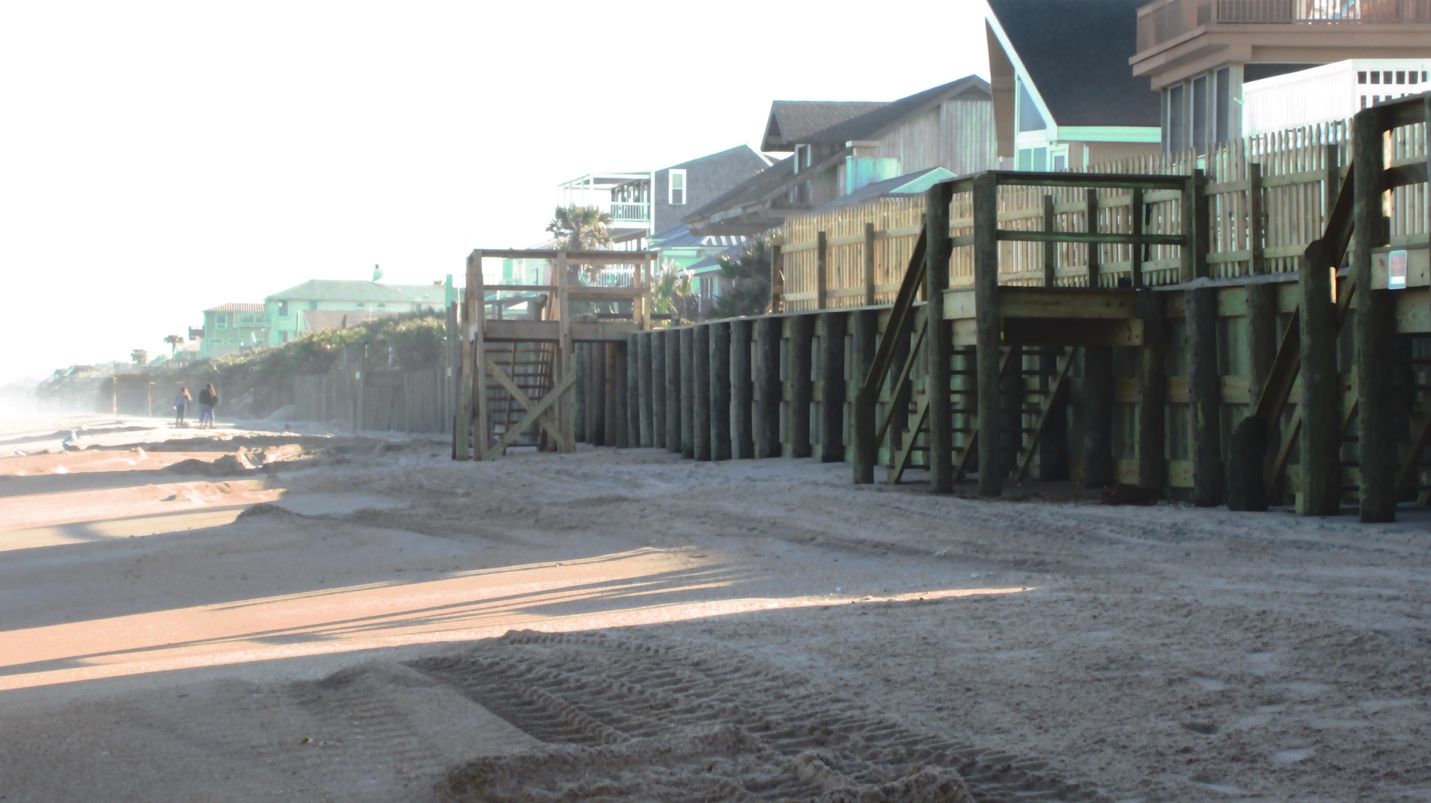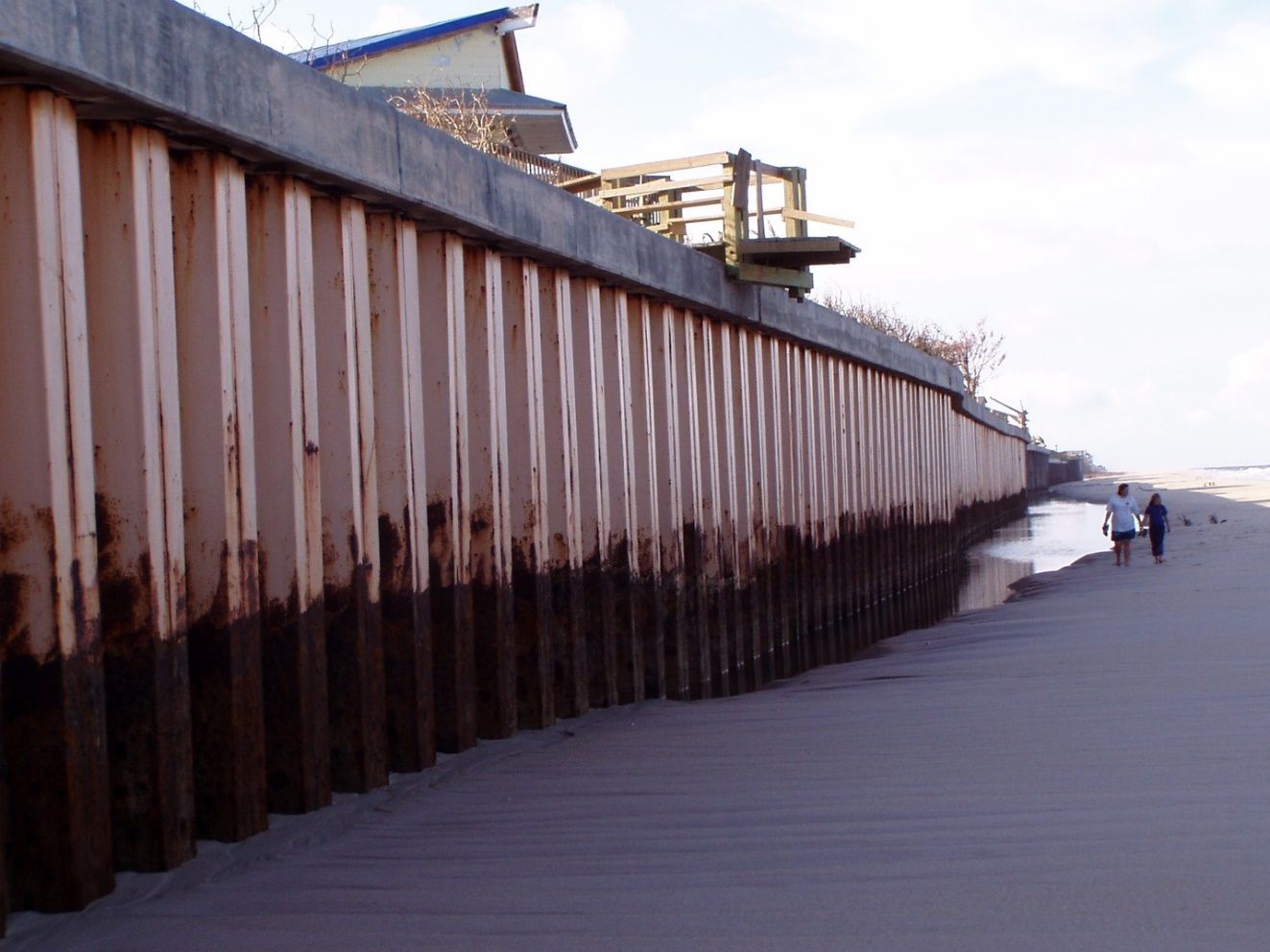This publication provides background information and alternative options to beach protection for coastal residents in Florida. It can also be used as a resource by local governments and Extension agents when communicating to coastal residents. We focus on coastal armoring and its associated impact on property as well as sea turtles while providing additional information on nature-based solutions as an alternative to coastal armoring.
Background
In 2021, close to 19.6 million people lived in Florida, and 76.5% of them, or approximately 15 million, lived in coastal areas (NOAA 2021). Florida’s coasts are attractive places to call home, and a history of coastal development has occurred in areas of high risk from coastal erosion. The density of coastal development has created high levels of exposure to both natural cycles of coastal changes and climate change risks (Bouwer 2019). These risks include sea-level rise and more frequent events such as hurricanes and coastal flooding (Mitchum 2011).
At particular risk from climate change are Florida’s 825 miles of sandy beaches. These sandy beaches are well known among tourists and residents, and they produce millions of dollars annually for Florida’s economy (FDEP 2020).
Where buildings are in the path of unnecessary risk, many beachfront communities are experiencing increased exposure to erosive events (McAneney and Crompton 2013). Many of these beachfront communities are a patchwork of houses, condos, businesses, and other privately owned properties. Due to the development history of these coastal communities, each property owner now likely needs to decide whether and how to increase resilience in the face of coastal erosion and flooding.
Among the wildlife impacted by coastal property owners’ choices are threatened and endangered sea turtles, which rely on Florida’s globally significant shores to nest (Witherington et al. 2011) (Figure 1). In fact, over five species of sea turtles rely on healthy sandy beaches to lay their eggs, including the federally endangered leatherback (Dermochelys coriacea), green (Chelonia mydas), hawksbill (Eretmochelys imbricata), and Kemp's ridley (Lepidochelys kempi), as well as the federally threatened loggerhead (Caretta caretta).

Credit: Gary Appelson
In total about ninety percent of all sea turtle nesting in the United States occurs in Florida (U.S. Fish and Wildlife Service 2021). Yet despite these federal listings and related protections, appropriate nesting habitat on Florida’s sandy beaches and dunes is being degraded and lost across the state as buildings have been sited too close to the beach. Some of this loss is made worse by climate change and sea-level rise (Griggs and Reguero 2021) and is further compounded by the decisions made by coastal landowners to install sea walls and similar protective structures intended to prevent erosion, a process often referred to as coastal armoring.
Coastal Armoring
Climate change effects, which include sea-level rise and hurricanes, tropical storms, and other severe storms, will continue to cause erosion, inundate low-lying coastal areas, and further stress the natural beach systems (Collins et al. 2017; Mitchum 2011). To preserve their disappearing beach, many property owners want to protect the shoreline and harden it through sea walls and similar hard protective structures. These hard structures, often referred to as coastal armoring, are placed on the sea side of buildings and designed with the goal of protecting buildings from storm, surf, and erosion damage.
Coastal armoring includes “structures that harden shoreline into a fixed position” (Witherington et al. 2011, p 457) such as sloping mounds of rocks (revetments); vertical seawalls made from concrete (Figures 1 and 2), wood (Figures 2 and 3), or steel (Figure 4); or geotubes, which are tubes filled with sand (Schroeder and Mosier 2000; Witherington et al. 2011; Witherington and Witherington 2015).

Credit: Gary Appelson

Credit: Gary Appelson

Credit: Gary Appelson
Impacts of Coastal Armoring on Property
Once installed, coastal armoring creates an unnatural barrier to the natural process of sediment movement on the beach. More specifically, coastal armoring stops the transfer of sediment between the surf and the dune, as well as along the coastline, creating sediment loss on the beach (Figure 5). Ultimately, coastal armoring deflects wave energy, which results in sediment removal both directly in front of the structure as well as adjacent to it, thus removing sand from both neighboring properties and the beach (Griggs and Reguero 2021; Nordstrom 2000; Schroeder and Mosier 2000).

Credit: Hill et. al 2019, adapted and reprinted with permission
While the specific impact of each coastal armoring structure is dependent on a variety of factors (such as the beach contour; wave patterns; and placement, material, and design of the coastal armoring structure) the general impacts to the beach remain the same (Griggs and Reguero 2021; Nordstrom 2000). As seen in Figure 5., coastal armoring causes the wave to rebound seaward onto the beach directly in front of and adjacent to the structure, increasing beach loss, instead of allowing the beach to retreat unimpeded (Dugan et al. 2008; Griggs 2005; Schroeder and Mosier 2000).
Additionally, during stronger storms including hurricanes, waves can flow over the armoring structure to cause damage from water becoming trapped behind the structure (Griggs 2005).
While many property owners pursue coastal armoring as their defense against erosion, there are several other options property owners can consider to protect their property. In fact, the Florida Administrative Code’s (FAC) rule titled Coastal Armoring and Related Structures begins by suggesting that, “applicants should be aware that armoring may not be the only option for providing protection. Applicants are encouraged to evaluate other protection methods such as foundation modification, structure relocation, and dune restoration” (Rule 62B-33.0051, FAC, 2008).
Structure relocation, or moving the building further inland, and foundation modification, or elevating the base height of a building are both structural alternatives to coastal armoring. Another option that property owners can consider is a living shoreline. Living shorelines are built to accommodate natural coastal processes of the area and are created with native plants, shellfish, or other naturally occurring elements (US Army 2017). In addition to reducing erosion, they can also provide protection from storms and enhance wildlife habitat.
If a property owner already has coastal armoring on their property, they can work with a coastal engineer to determine if they can convert their existing structure to a living shoreline. Additionally, coastal community members can stay apprised of local land-use planning and resilience projects and work to advocate for improved coastal planning policies and living shoreline projects for their community.
A number of resources are available with additional information on designing and installing living shorelines in Florida. Please see the Resources section with links provided by Florida Fish and Wildlife Conservation Commission, University of Florida Institute of Food and Agricultural Science, and the Florida Department of Environmental Protection.
Impacts of Coastal Armoring on Sea Turtles
While the impacts of coastal armoring to the beach-dune ecosystem and private property can be unfortunate, the consequences for nesting sea turtles can be disastrous. They may be unable to reach nest sites, may be discouraged from nesting, or may lay eggs in an inappropriate spot only to have the eggs destroyed by tides and storms (Figures 1 and 2). Nest site selection is key for successful incubation of eggs and requires specific beach conditions which vary slightly among beaches, between different sites on the same beach, and with the climatic conditions of a given year. Many species of sea turtles employ a “scatter-nesting” strategy, placing their successive nests at various locations along the beach profile to ensure that some will survive tidal and climatic extremes (Mrosovsky 1983; Pfaller et al. 2017).
The beach needs to have enough accessible sand above the mean high water, shoreward of the average high-water height (Witherington et al. 2011). The impact of coastal armoring on sea turtle nesting habitat is mainly loss of suitable nesting habitat and increase of mortality of eggs (Mosier 1998; Rizkalla and Savage 2011; Schroeder and Mosier 2000; Witherington et al. 2011). Additionally, sea turtles have been deterred from nesting sites in areas with coastal armoring and may abandon their egg laying efforts altogether (Schroeder and Mosier 2000; Witherington et al. 2011).
While coastal armoring poses a truly complex problem, its main impact to nesting sea turtles is loss and degradation of nesting habitat. Sea turtles generally return to nest on the area of coastline and sometimes even the same beach where they were hatched. By necessity this “natal-homing” involves a degree of flexibility in site-selection, because over geological and even annual timeframes, old beaches disappear and new ones are formed. However, the incubation temperature requirements of sea turtle eggs limit the extent of actual usable beaches by latitude and season. Coastal armoring decreases the overall number of suitable beaches and limits the usable nesting space on individual beaches (Eastman and Appelson 2017). Interspersing natural and armored beaches may not present a viable solution, since as discussed earlier, armoring can severely disrupt wave rebound and sediment transport patterns along a coastline, and this can often occur in an unpredictable manner. Beach armoring is done to protect development on the coast, and this development can include other factors such as lighting and noise that are not conducive to successful sea turtle nesting.
Concluding Remarks
Many structures have been built in harm’s way along the coast of Florida. As exposure to risks from climate change and sea-level rise increases, more property owners are using coastal armoring. The use of coastal armoring on Florida’s beaches separates the beach and dune habitat while accelerating the pace of erosion to the sandy beach both in front of and adjacent to the armoring. As sea levels rise and resulting coastal flood risk heightens, coastal communities and property owners will all face increasingly difficult management decisions. Implementing strategies like living shorelines that protect both coastal communities and the beach-dune ecosystem will be critical if Florida is to remain a haven for tourists, residents, and sea turtles.
Resources
Coastal Erosion: https://ncbs.ifas.ufl.edu/extension/dealing-with-coastal-erosion/coastal-erosion/ https://ncbs.ifas.ufl.edu/extension/dealing-with-coastal-erosion/coastal-erosion/
EDIS Living Shorelines: https://edis.ifas.ufl.edu/entity/topic/living_shorelines
Florida Fish and Wildlife Conservation Commission Living Shorelines: https://myfwc.com/conservation/special-initiatives/cwci/living-shorelines/
Florida Department of Environmental Protection Living Shorelines: https://floridadep.gov/rcp/resilient-florida-program/content/resilient-florida-program-living-shorelines
References
Bouwer, L. M. 2019. “Observed and Projected Impacts from Extreme Weather Events: Implications for Loss and Damage” in Loss and Damage from Climate Change, edited by R. Mechler, L. Bouwer, T. Schinko, S. Surminski, and J. Linnerooth-Bayer. Climate Risk Management, Policy and Governance. Springer, Cham. https://doi.org/10.1007/978-3-319-72026-5_3
Collins, J. M., C. H. Paxton, T. Wahl, and C. T. Emrich. 2017. “Climate and Weather Extremes.” Florida's Climate: Changes, Variations, and Impacts. Retrieved from https://doi.org/10.17125/fci2017.ch20
Dugan, J. E., D. M. Hubbard, I. F. Rodil, D. L. Revell, and S. Schroeter. 2008. “Ecological Effects of Coastal Armoring on Sandy Beaches.” Marine Ecology 29:160–170. doi:10.1111/j.1439-0485.2008.00231.x
Eastman, S., and G. Appelson. 2017. Coastal Armoring and Rising Seas Put a Squeeze on Turtles. SWOT Report, vol. 12:12–13.
Florida Administrative Code (2008). 62B- 33.0051: Coastal Armoring and Related Structures. https://www.flrules.org/gateway/ruleno.asp?id=62B-33.0051&Section=0
Florida Department of Environmental Protection. 2020. Strategic Beach Management Plan — Introduction. Retrieved October 13, 2021, from https://floridadep.gov/rcp/beaches-inlets-ports/documents/introduction-strategic-beach-management-plan.
Griggs, G. B. 2005. The Impacts of Coastal Armoring. Shore and Beach 73 (1): 13–22. Retrieved on November 1, 2021, from https://www.researchgate.net/publication/285969581_The_impacts_of_coastal_armoring
Griggs, G. B., and B. G. Reguero. 2021. “Coastal Adaptation to Climate Change and Sea-Level Rise.” Water 13 (16): 2151. https://doi.org/10.3390/w13162151
Hill, M. K., M. C. Monroe, T. T. Ankersen, R. R. Carthy, and T. A. Kay. 2019. “Coastal Armoring and Sea Turtles: Beachfront Homeowners’ Opinions and Intent.” Coastal Management 47 (6): 594–610. https://doi.org/10.1080/08920753.2019.1669102
McAneney, J., and R. Crompton. 2013. “What is driving the rising cost of natural disasters?” Trébol, (67):5–17 https://app.mapfre.com/mapfrere/docs/html/revistas/trebol/n67/pdf/Articulo1-en.pdf
Mitchum, G. T. 2011. “Sea Level Changes in the Southeastern United States: Past, Present, and Future.” University of South Florida. Florida Climate Institute and Southeast Climate Consortium. Retrieved October 13, 2021, from https://floridaclimateinstitute.org/images/reports/201108mitchum_sealevel.pdf
Mrosovsky, N. 1983. “Ecology and Nest-Site Selection of Leatherback Turtles (Dermochelys coriacea).” Biological Conservation 26:47–56. https://doi.org/10.1016/0006-3207(83)90047-2
NOAA Office for Coastal Management. 2021. Florida. Retrieved October 13, 2021, from https://coast.noaa.gov/states/florida.html
Pfaller, J. B., C. J. Limpus, and K. A. Bjorndal. 2008. “Nest-Site Selection in Individual Loggerhead Turtles and Consequences for Doomed-Egg Relocation.” Conservation Biology 23 (1): 72–80. https://doi.org/10.1111/j.1523-1739.2008.01055.x
Rizkalla, C. E., and A. Savage. 2011. “Impact of Seawalls on Loggerhead Sea Turtle (Caretta caretta) Nesting and Hatching Success.” Journal of Coastal Research 27 (1): 166–173. doi: 10.2112/JCOASTRES-D-10-00081.1
Schroeder, B. A., and A. E. Mosier. 2000. Between a Rock and a Hard Place: Coastal Armoring and Marine Turtle Nesting Habitat in Florida.” Paper presented at Eighteenth International Sea Turtle Symposium. U.S. Department of Commerce. NOAA Technical Memorandum NMFS-SEFSC-436 290–292. Retrieved October 13, 2021, from http://www.seaturtle.org/PDF/AbreuGroboisFA_2000_ProceedingsoftheEighteenthInternati.pdf
US Army Corps of Engineers. 2017. Nationwide Permit 54 - Living shorelines, effective date: March 19, 2017; Expiration Date: March 14, 2026 (NWP Final Notice, 82 FR 1860), from https://www.swt.usace.army.mil/Portals/41/docs/missions/regulatory/2021%20NWP/NWP-54.pdf?ver=5LdLM2jDQyrn9GykSMxjKw%3d%3d
U.S. Fish and Wildlife Service, Environmental Conservation Online System – Species Reports. Retrieved October 13, 2021, from https://ecos.fws.gov/ecp/report/species-listings-by-tax-group?statusCategory=Listed&groupName=Reptiles
Witherington, B., S. Hirama, and A. Mosier. 2011. “Barriers to Sea Turtle Nesting on Florida (USA) Beaches: Linear Extent and Changes Following Storms.” Journal of Coastal Research 27 (3): 450–458. doi: https://doi.org/10.2112/JCOASTRES-D-09-00146.1
Witherington, B. E., and D. Witherington. 2015. Our Sea Turtles: A Practical Guide for the Atlantic and Gulf, from Canada to Mexico.” Sarasota, FL: Pineapple Press, Inc.